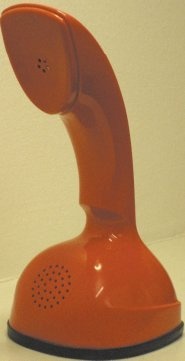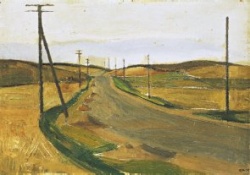We have Many Names for the Things we Love
01. May. 2008

Ericophone, L.M. Ericsson, 1956
The Microtelephone
In the first telephones after 1876 the microphone and the telephone were separate. You spoke into a microphone and you held the telephone to your ear and listened to it. In direct translation telephone means "distant sound". In the early 1890's, when the microphone and the telephone were built into one unit, it was called a "microtelephone". The word has followed the professionals until today whilst the most common expression for the microtelephone among ordinary people has been „the receiver". The telephone has been called different names dependent on its design. When telephones began to be produced of bakelite and plastic, the microtelephone was often called "the bone" or "the negro bone" dependent of the colour of the telephone, or simply "the receiver".
Nicknames
Several telephones have had nicknames through the years. In 1892, an apparatus with microtelephone - i.e. receiver - and a winding handle was introduced. It soon got the name "the Sewing Machine". The apparatus was also called „the Lyre Foot Telephone", allegedly because of the shape of its legs. In 1956, the Ericophone was put on the market. Its snakelike upright shape gave it the nickname "the Cobra". On the island of Funen it was called "the Field Chopper" due to its resemblance with the funnel on a field ensilage harvester.
In the early 1950's when automation of the exchanges in Denmark really gathered speed, the subscriber's telephone was replaced by a dial telephone. In ordinary parlance it was known as a "turntable telephone". If a professional was asked, he would say "dial" because to other professionals a turntable is the disk used when a train is switching to the engine shed. In the 1960's, the dial was replaced with a keyboard so that one could press the number instead of dialling it. Used colloquially it became a „push-button phone", but to professionals it is still a keyboard apparatus.

Telephone Poles in Central Jutland portrayed by the artist Erik Raadal in his painting "Highway" from 1935. Post & Tele Museum.
Telephone Wire?
What is in the normal run of things known as the telephone wire, is called "cord" or "lead" by professionals. It is the wire connecting the micro telephone - i.e. the receiver - with the telephone apparatus and the telephone apparatus with the pluck outlet in the wall respectively. To professionals a telephone wire is the wire from the socket and out of the house.
Telephone Poles?
Before telephone cables were buried they were hanging in the air from some "poles". When contemplating the landscape one could see a long row of poles along the highway. The linesmen working there did "pole work" and when they climbed the poles, they were wearing "spurs". Among people the poles were also called telephone masts.
This article may be copied or quoted with MuseumsPosten, Post & Tele Museum as source.
Comment this article
Only serious and factual comments will be published.